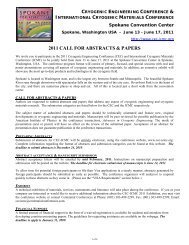CEC Abstracts in PDF format (as of 7/3/07) - CEC-ICMC 2013
CEC Abstracts in PDF format (as of 7/3/07) - CEC-ICMC 2013
CEC Abstracts in PDF format (as of 7/3/07) - CEC-ICMC 2013
You also want an ePaper? Increase the reach of your titles
YUMPU automatically turns print PDFs into web optimized ePapers that Google loves.
<strong>CEC</strong> 20<strong>07</strong> - <strong>Abstracts</strong><br />
C3-K-06 Cost-Efficient Storage <strong>of</strong> Cryogens<br />
J.E. Fesmire, J.P. S<strong>as</strong>s, D.L. Morris, NASA KSC; Z.F.<br />
Nagy, S.D. Augustynowicz, Sierra Lobo, Inc.; S.J.<br />
Sojourner, ASRC Aerospace.<br />
NASA’s critical cryogenic <strong>in</strong>fr<strong>as</strong>tructure that supports launch vehicle<br />
operations and propulsion test<strong>in</strong>g is reach<strong>in</strong>g an age where major<br />
refurbishment will soon be required. A key element <strong>of</strong> this<br />
<strong>in</strong>fr<strong>as</strong>tructure is the <strong>in</strong>sulation <strong>in</strong> large double-walled cryogenic<br />
storage tanks, for which perlite h<strong>as</strong> been the <strong>in</strong>sulation material <strong>of</strong><br />
choice for decades. New materials are now available that can provide<br />
improved thermal and mechanical performance. An <strong>in</strong>ternal research<br />
and development project <strong>in</strong>vestigated the application <strong>of</strong> new bulk-fill<br />
<strong>in</strong>sulation materials and <strong>as</strong>sociated technology upgrades to advance<br />
the overall efficiency <strong>of</strong> cryogenic storage tanks. Technical, safety<br />
and affordability data were produced to support NASA program<br />
decisions on the benefits and risks <strong>of</strong> us<strong>in</strong>g the alternative <strong>in</strong>sulation<br />
materials, <strong>in</strong>clud<strong>in</strong>g gl<strong>as</strong>s microspheres and aerogel beads. Work w<strong>as</strong><br />
divided <strong>in</strong>to three are<strong>as</strong>: material test<strong>in</strong>g (thermal conductivity and<br />
physical characterization), tank demonstration test<strong>in</strong>g (liquid nitrogen<br />
and liquid hydrogen), and system studies (thermal model<strong>in</strong>g,<br />
economic analysis, and <strong>in</strong>sulation changeout). The research work<br />
presents a more cost-effective solution for large-scale cryogenic<br />
storage worldwide, new cryogenic test equipment and methods, and a<br />
pathway for m<strong>as</strong>s-efficient storage and transfer <strong>of</strong> cryogens on the<br />
Moon and Mars.<br />
Fund<strong>in</strong>g w<strong>as</strong> provided by the NASA Space Operations Mission<br />
Directorate under the Internal Research and Development project<br />
New Materials and Technologies for Cost-Efficient Storage and<br />
Transfer <strong>of</strong> Cryogens.<br />
C3-L Accelerator Cryogenics<br />
C3-L-01 Cooldown <strong>of</strong> the first sector <strong>of</strong> the Large Hadron<br />
Collider: comparison between mathematical model and<br />
me<strong>as</strong>urements<br />
L. Liu, Ch<strong>in</strong>ese Academy <strong>of</strong> Sciences; G. Riddone, L.<br />
Tavian, CERN.<br />
The first LHC sector (3.3-km long) will be cooled down for the first<br />
time from room temperature to 1.8 K at the beg<strong>in</strong>n<strong>in</strong>g <strong>of</strong> the year<br />
20<strong>07</strong>. For this cool-down, the m<strong>as</strong>s-flow distribution <strong>of</strong> each cell h<strong>as</strong><br />
been optimized us<strong>in</strong>g a mathematical model developed to establish<br />
reference set-po<strong>in</strong>ts. In this paper, the me<strong>as</strong>ured evolution <strong>of</strong><br />
temperatures, pressures, m<strong>as</strong>s-flow rates <strong>of</strong> helium <strong>in</strong> each cell <strong>of</strong> the<br />
mach<strong>in</strong>e <strong>as</strong> well <strong>as</strong> <strong>in</strong> the cryogenic distribution l<strong>in</strong>e will be presented<br />
and compared with the simulation results obta<strong>in</strong>ed from the previous<br />
mathematical model. Possible discrepancies between me<strong>as</strong>urements<br />
and calculation will be also analyzed for improv<strong>in</strong>g the mathematical<br />
model.<br />
C3-L-02 Commission<strong>in</strong>g the cryogenic system <strong>of</strong> the first<br />
LHC sectors<br />
F. Millet, S. Claudet, G. Ferl<strong>in</strong>, P. Gomes, S. Junker,<br />
G. Riddone, M. Soubiran, L. Tavian, B. Vullierme, U.<br />
Wagner, CERN; L. Ronayette, L. Serio, CNRS.<br />
The LHC mach<strong>in</strong>e, composed <strong>of</strong> eight sectors with superconduct<strong>in</strong>g<br />
magnets and cavities requires a complex cryogenic system provid<strong>in</strong>g<br />
high cool<strong>in</strong>g capacities (equivalent to 18 kW at 4.5 K and 2.4 kW at<br />
1.8 K per sector produced <strong>in</strong> large cold boxes and distributed via 3.3-<br />
km cryogenic transfer l<strong>in</strong>es). After <strong>in</strong>dividual reception tests <strong>of</strong> the<br />
cryogenic subsystems (cryogen storages, refrigerators, cryogenic<br />
transfer l<strong>in</strong>es and distribution boxes) performed s<strong>in</strong>ce 2000, the<br />
commission<strong>in</strong>g <strong>of</strong> the cryogenic system <strong>of</strong> the first LHC sectors is<br />
under way s<strong>in</strong>ce November 2006.<br />
After a brief description <strong>of</strong> the LHC cryogenic system and its<br />
specificities, the commission<strong>in</strong>g will be reported detail<strong>in</strong>g the<br />
preparation ph<strong>as</strong>e (pressure and leak tests, condition<strong>in</strong>g and flush<strong>in</strong>g),<br />
the cool-down or warm-up sequences <strong>in</strong>clud<strong>in</strong>g the handl<strong>in</strong>g <strong>of</strong><br />
cryogenic fluids and f<strong>in</strong>ally the power<strong>in</strong>g ph<strong>as</strong>e <strong>of</strong> magnets and<br />
cavities. Prelim<strong>in</strong>ary conclusions <strong>of</strong> the commission<strong>in</strong>g <strong>of</strong> the first<br />
LHC sectors will be drawn with the review <strong>of</strong> the critical po<strong>in</strong>ts<br />
solved or still pend<strong>in</strong>g. F<strong>in</strong>ally this paper will report on the first<br />
operation experience <strong>of</strong> the LHC cryogenic system <strong>in</strong> perspective <strong>of</strong><br />
the commission<strong>in</strong>g <strong>of</strong> the rema<strong>in</strong><strong>in</strong>g LHC sectors and the beam<br />
<strong>in</strong>jection test.<br />
C3-L-03 Validation and Performance <strong>of</strong> the LHC<br />
Cryogenic System Through Commission<strong>in</strong>g <strong>of</strong> the First<br />
Sectors<br />
L. Serio, CERN.<br />
The cryogenic system for the Large Hadron Collider accelerator is<br />
presently <strong>in</strong> its f<strong>in</strong>al ph<strong>as</strong>e <strong>of</strong> commission<strong>in</strong>g at nom<strong>in</strong>al operat<strong>in</strong>g<br />
conditions. The refrigeration capacity for the LHC is produced us<strong>in</strong>g<br />
eight large cryogenic plants and eight 1.8 K refrigeration units<br />
<strong>in</strong>stalled on five technical sites. Mach<strong>in</strong>e cryogenic equipments are<br />
<strong>in</strong>stalled <strong>in</strong> a 26.7 km circumference r<strong>in</strong>g deep underground tunnel<br />
and are ma<strong>in</strong>ta<strong>in</strong>ed at their nom<strong>in</strong>al operat<strong>in</strong>g conditions via a<br />
distribution system consist<strong>in</strong>g <strong>of</strong> transfer l<strong>in</strong>es, cold <strong>in</strong>terconnection<br />
boxes at each technical site and a cryogenic distribution l<strong>in</strong>e.<br />
The functional analysis <strong>of</strong> the whole system dur<strong>in</strong>g all operat<strong>in</strong>g<br />
conditions w<strong>as</strong> established and validated dur<strong>in</strong>g the first sectors tests<br />
<strong>in</strong> order to maximize the system availability and m<strong>in</strong>imize the<br />
operation cost. The analysis, operat<strong>in</strong>g modes, ma<strong>in</strong> failure scenarios,<br />
results and performances <strong>of</strong> the cryogenic system are presented.<br />
C3-L-04 Thermal test <strong>of</strong> the cryogenic distribution l<strong>in</strong>e <strong>of</strong><br />
the first complete sector <strong>of</strong> the Large Hadron Collider<br />
K. Brodz<strong>in</strong>ski, S. Claudet, J. Fydrych, F. Millet, G.<br />
Riddone, L. Serio, M. Strychalski, L. Tavian, CERN;<br />
M. Chorowski, Wroclaw University <strong>of</strong> Technology.<br />
The first <strong>of</strong> the eight sectors <strong>of</strong> the Large Hadron Collider (LHC) h<strong>as</strong><br />
been completely <strong>in</strong>stalled <strong>in</strong> the underground tunnel and connected to<br />
its cryogenic distribution l<strong>in</strong>e (QRL). The QRL will distribute the<br />
g<strong>as</strong>eous and supercritical helium along the 3.3-km long sector. In the<br />
so-called service modules the supercritical helium is sub-cooled and<br />
then expanded to produce saturated 1.8 K superfluid helium This<br />
helium is used <strong>as</strong> cryogenic refrigerant for the accelerator<br />
superconduct<strong>in</strong>g magnets already immersed <strong>in</strong> a superfluid helium<br />
bath at 1.9 K.<br />
One <strong>of</strong> the next milestones, after the successful thermo-mechanical<br />
validation <strong>of</strong> the QRL alone, carried out <strong>in</strong> 2005, is the hardware<br />
commission<strong>in</strong>g <strong>of</strong> first complete sector <strong>of</strong> the LHC. One <strong>of</strong> the ma<strong>in</strong><br />
issues <strong>of</strong> this commission<strong>in</strong>g is the heat <strong>in</strong>leak me<strong>as</strong>urements to the<br />
different circuits located <strong>in</strong> the QRL <strong>as</strong> well <strong>as</strong> <strong>in</strong> the LHC mach<strong>in</strong>e.<br />
The paper describes the applied heat <strong>in</strong>leak me<strong>as</strong>urement<br />
methodology, its accuracy and error estimation, <strong>as</strong> well <strong>as</strong> presents the<br />
ma<strong>in</strong> results <strong>of</strong> the me<strong>as</strong>ured heat <strong>in</strong>leaks at the different temperature<br />
levels. The me<strong>as</strong>ured heat <strong>in</strong>leaks will be also compared to the results<br />
obta<strong>in</strong>ed from the test <strong>of</strong> the QRL alone.<br />
C3-M Pulse Tube Theory and Models<br />
C3-M-01 Performance Limits <strong>of</strong> 3He <strong>in</strong> Pulse Tube<br />
Cryocoolers<br />
P. Kittel, Consultant.<br />
The enthalpy, entropy, and exergy flows <strong>of</strong> the real g<strong>as</strong> effects <strong>of</strong> 4He<br />
<strong>in</strong> ideal pulse tube cryocoolers have been described previously.<br />
Huang, et. al, have recently developed a computer program for the<br />
thermophysical properties <strong>of</strong> 3He. This paper uses this model to<br />
describe how the thermodynamic flows are affected by real g<strong>as</strong><br />
phenomena <strong>of</strong> 3He <strong>in</strong> ideal pulse tube cryocoolers.<br />
Frequently such descriptions take an energy-centric view,<br />
concentrat<strong>in</strong>g on the first law <strong>of</strong> thermodynamics, the conservation <strong>of</strong><br />
energy. This approach can result <strong>in</strong> a complex description <strong>of</strong> the<br />
cooler <strong>in</strong> terms <strong>of</strong> energy and enthalpy flows.<br />
An alternative is to take an entropy-centric approach. Closely related<br />
to this is the exergy-centric approach. These descriptions concentrate<br />
on the second law <strong>of</strong> thermodynamics, the generation <strong>of</strong> entropy or<br />
the destruction <strong>of</strong> exergy.<br />
Both the energy-centric and exergy/entropy-centric approaches make<br />
use <strong>of</strong> both the laws <strong>of</strong> thermodynamics and both approaches give<br />
equivalent descriptions <strong>of</strong> a cryocooler. However, the latter approach<br />
can be more useful <strong>as</strong> it can yield a simpler description, one that<br />
emph<strong>as</strong>izes loss mechanisms.<br />
This paper applies the second law approach to pulse tube cryocoolers.<br />
The non-ideal g<strong>as</strong> effects <strong>of</strong> 3He <strong>in</strong> Pulse Tube cryocoolers are<br />
discussed and compared to similar effects from 4He.<br />
This work w<strong>as</strong> funded through University Affiliated Research Center<br />
(UARC) Subcontract P0228861. The UARC is managed by the<br />
University <strong>of</strong> California, Santa Cruz under NASA Ames Research<br />
Center Contract NAS2-03144.<br />
Page 44 <strong>of</strong> 53






